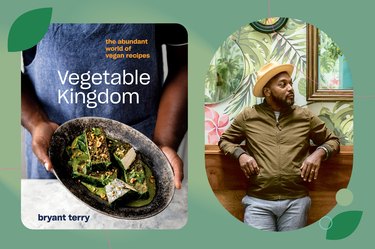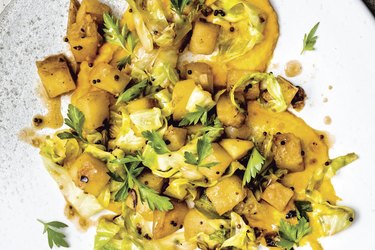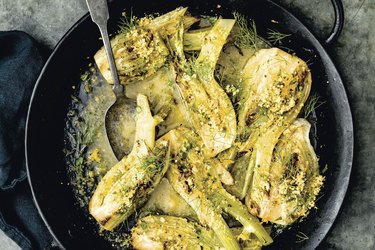
Bryant Terry, the James Beard & NAACP Image Award-winning chef, educator, activist and author, has spent his career encouraging others, especially Black people, to eat in healthy and sustainable ways.
He pays homage to and calls for the remembrance of Black food traditions in his recipes and in his work. His latest book, Black Food, pays tribute to Black food ingenuity and features more than 100 cultural movers and shakers, exploring the Black experience via recipes, essays and artwork.
Video of the Day
Video of the Day
Also at the heart of his decades-long career is his fight for food justice. Food justice is a social movement that advocates for universal access to nutritious, affordable and culturally appropriate food for everyone, per Boston University.
Plant-based eating and veganism have long been co-opted by the mainstream, making it a food justice issue. Racial and economic inequality has caused a lack of food access to communities of color.
As a result, Black people and other communities of color are often excluded from the discourse that extolls the many benefits of plant-based eating — despite the fact that meat-free diets aren't new to people of color, who have found their own ways to make plant-based eating flavorful and life-sustaining.
Terry's recipes and cookbooks encourage everyone to reimagine what's possible with plant-based eating, while also reminding Black people to reconnect with and reclaim our food traditions.
Ahead are three recipes from his book Vegetable Kingdom, which marries African Diasporic and Asian cuisines, while teaching you the basics of making a great vegan meal. Plus, see how Terry pairs each recipe with a soulful song.
Buy Bryant Terry's Books
- Vegetable Kingdom: $26.94, Amazon.com
- Black Food: $26.94, Amazon.com
1. Spinach and Kale Grit Cakes
If you don't have grits and greens lying around your kitchen, you'll be sure to always keep them in stock after trying this creamy and subtly spicy meal.
You can make this dish low-fat by cooking the grit cakes on a lightly greased baking sheet at 325 degrees Fahrenheit for about 15 minutes on each side.
Ingredients
Makes 4 to 6 servings
For the Creamy Creole Sauce:
- 3 tablespoons extra-virgin olive oil
- 3 tablespoons millet flour
- 1 cup 1/4-inch diced yellow onions
- 1/2 cup finely chopped celery
- 1/2 cup 1/4-inch diced green bell pepper
- 1 teaspoon minced garlic
- 1 teaspoon Creole Seasoning (recipe follows)
- 1/4 teaspoon kosher salt, plus more as needed
- 3 tablespoons tomato paste
- 1 tablespoon Bragg Liquid Aminos
- 1 cup vegetable stock
- 1/3 cup Cashew Cream (recipe follows)
For the Grit Cakes:
- 3 cups unflavored almond milk
- 1 cup vegetable stock
- 1 cup stone-ground corn grits, soaked in water overnight and drained
- 1 tablespoon extra-virgin olive oil, plus more for frying
- 1 cup cleaned and chopped leek, white part only (about 1 medium) 1
- 1/2 teaspoon kosher salt
- 2 teaspoons minced garlic
- 3/4 cup stemmed and chopped lacinato kale greens
- 3/4 cup chopped baby spinach
- 1/3 cup thyme sprigs, for garnish
For the Creole Seasoning:
Makes about 1/4 cup
- 1 tablespoon garlic powder
- 1 tablespoon paprika
- 2 teaspoons coarse sea salt
- 2 teaspoons freshly ground black pepper
- 2 teaspoons onion powder
- 2 teaspoons chili powder
- 2 teaspoons red pepper flakes
- 1 teaspoon dried thyme
- 1 teaspoon dried oregano
- 1/2 teaspoon cayenne pepper
For the Cashew Cream:
Makes about 1 cup
- 1 cup raw cashews, soaked in water overnight and drained well
Instructions
Step 1: Make the Cream
Combine the cashews and 1/2 cup water in a blender and blend until smooth and creamy.
Step 2: Make the Sauce
- In a medium saucepan over medium-low heat, warm 2 tablespoons of oil until shimmering.
- Slowly whisk in the millet flour. Cook, stirring constantly, for about 15 minutes.
- Stir in the remaining 1 tablespoon oil, the onions, celery and bell pepper and cook, stirring frequently until the vegetables soften, about 5 minutes.
- Stir in the garlic, Creole seasoning, salt, tomato paste and liquid aminos. Cook, stirring constantly, for 2 minutes.
- Stir in the vegetable stock and cashew cream and bring to a simmer. Simmer the sauce, stirring occasionally, until starting to thicken, about 20 minutes.
- Season with salt to taste. Remove from heat and set aside.
Step 3: Make the Grit Cakes
- In a medium saucepan, combine the almond milk and stock and bring to a simmer over medium heat.
- While whisking constantly, slowly pour in the grits. Continue to whisk until no lumps remain. Bring to a simmer, still whisking, then reduce the heat to low.
- Simmer the grits, stirring every 2 to 3 minutes to prevent sticking, until tender and very thick, 30 to 45 minutes.
- Meanwhile, warm the olive oil in a small skillet over medium heat. When the oil is shimmering, add the leek and salt. Cook, stirring until well-browned, 10 to 15 minutes. Add the garlic and sauté until fragrant, 2 to 3 minutes. Remove from the heat and set aside.
- Combine the kale greens, spinach, and 6 tablespoons of water in a blender. Puree until very smooth, scraping down the sides as necessary, 1 to 2 minutes. Set aside.
- Once the grits are done, scrape in the spinach and kale green mixture and the leek mixture and stir well. Continue to simmer on low heat, stirring frequently, until most of the additional liquid has been absorbed and the grits are once again very thick, 10 to 15 minutes.
- Pour the grits into a 9-inch square baking dish and spread them out with a rubber spatula. Refrigerate and allow the grits to rest until firm, about 3 hours or up to overnight.
- When you're ready to finish the cakes, preheat the oven to 250 F. Flip the grits out onto a cutting board and slice into 16, 2-inch squares.
- In a large nonstick skillet, warm a scant tablespoon of olive oil over medium-high heat. When the oil is hot, pan-fry the cakes in batches until golden brown and crisp, 2 to 3 minutes per side.
- Transfer the cooked cakes to a baking sheet and keep them warm in the oven until all of the cakes are cooked. Before serving, warm the sauce. Spread sauce on individual plates, top with a few grit cakes, pour sauce over the grit cakes, then garnish with thyme.
Pair With This Song
“Portrait of a Wellman Braud” by Duke Ellington from the album New Orleans Suite.
Reprinted with permission from Vegetable Kingdom: The Abundant World of Vegan Recipes by Bryant Terry, copyright© 2020. Published by Ten Speed Press, an imprint of Penguin Random House." Photography copyright: Ed Anderson © 2020
2. Sauteed Cabbage and Roasted Potatoes
Terry's inspiration for this dish was the hearty Ethiopian dish Atakilt — a slow-cooked meal made from potatoes, cabbage and carrots. This remixed version also invites Caribbean flavors thanks to the sprinkle of acidic ginger-habanero vinegar that tops it off.
Ingredients
Makes 4 servings
- 2 pounds of Yukon gold potatoes, cut into 1/2-inch cubes
- 4 tablespoons extra-virgin olive oil
- 2 teaspoons coarse sea salt, plus more as needed
- Freshly ground white pepper
- 1 pound carrots, thinly sliced
- 1 teaspoon red wine vinegar, plus more as needed
- 2 teaspoons brown mustard seeds
- 1/4 to 1/2 teaspoon red pepper flakes
- 1 teaspoon raw cane sugar
- 8 ounces green cabbage, cored and thinly sliced
- 6 tablespoons vegetable stock or water
- Ginger-Habanero Vinegar (see recipe below)
- 1/2 cup loosely packed fresh flat-leaf parsley leaves, for garnish
For the Ginger-Habanero Vinegar:
Makes about 1 cup
- 3 habanero chiles, stemmed and seeded
- ½ cup unseasoned rice vinegar
- ½ cup distilled white vinegar
- 1½ teaspoons minced fresh ginger
- 1 teaspoon raw cane sugar
- Pinch of kosher salt
Instructions
Step 1: Make the Ginger-Habanero Vinegar
- Place the chiles in a heatproof bowl. In a small saucepan, combine the rice and white vinegars, ginger, sugar and salt and bring to a boil over high heat.
- Immediately pour the vinegar mixture over the chiles and let cool completely.
- Transfer to a jar, seal and store at room temperature for up to 1 year.
Step 2: Make the Cabbage and Potatoes
- Preheat the oven to 450 F. Line a baking sheet with parchment paper.
- In a large bowl, combine the potatoes, 1 tablespoon of the olive oil, 1 teaspoon of salt and a few turns of white pepper and toss well with clean hands to combine. Spread the potatoes over the prepared baking sheet in one layer and roast until tender and starting to turn golden on the edges, 35 to 40 minutes.
- While the potatoes are roasting, in a medium saucepan, combine the carrots, 3/4 cup water and 1/2 teaspoon of the salt. Bring to a boil over medium-high heat, stir and quickly decrease the heat to medium-low. Partially cover and steam the carrots until tender, about 15 minutes.
- Drain the carrots in a colander and let them sit until they have dried, about 20 minutes. Transfer the carrots to a blender, add the red wine vinegar and 1 tablespoon of the olive oil and puree until smooth, adding a little water if necessary. Taste, add more vinegar to brighten the puree if necessary and season with salt and white pepper. Set aside.
- Heat a large sauté pan over medium heat. Add the remaining 2 tablespoons olive oil, the mustard seeds, red pepper flakes, sugar and remaining 1/2 teaspoon salt. Simmer, stirring frequently to prevent the spices from burning, until the mustard seeds start to pop, about 2 minutes.
- Quickly add the cabbage and sauté, stirring often, until completely wilted, about 3 minutes. Add the stock and the roasted potatoes and gently toss to combine.
- Cover and cook until most of the liquid has evaporated, about 4 minutes.
- Season with salt and white pepper to taste.
- To serve, slather the carrot puree over four plates, scoop a mound of the sautéed cabbage and potatoes on top and generously sprinkle with ginger-habanero vinegar. Garnish with the parsley leaves and serve.
Pair With This Song
“Wubit” by Mulatu Astatke & Black Jesus Experience from the album Cradle of Humanity.
Reprinted with permission from Vegetable Kingdom: The Abundant World of Vegan Recipes by Bryant Terry, copyright© 2020. Published by Ten Speed Press, an imprint of Penguin Random House." Photography copyright: Ed Anderson © 2020
3. Citrus and Garlic-Herb Braised Fennel
You may never eat plain ol' pan-seared fennel again after you try this version. This rich dish is bright-tasting thanks to the notes of orange and lime, but it's also a little saucy thanks to the sunchoke sauce.
If you're new to sunchokes, they're a knobby root vegetable that's comparable to potatoes, although they look like ginger root. They're rich in fiber, magnesium and potassium. While the vegetable is hard to come by in supermarkets, it can often be found at farmers' markets in the fall and winter.
Ingredients
Makes 4 servings
For the Citrus and Garlic-Herb Sauce:
- 1 cup fresh orange juice
- 1/4 cup fresh lime juice
- 1 tablespoon white vinegar
- 5 garlic cloves, minced
- 1 tablespoon minced fresh parsley leaves
- 1/2 teaspoon ground cumin
- 1/4 teaspoon kosher salt
For the Fennel:
- 2 large fennel bulbs with fronds
- 5 tablespoons olive oil
- Fine sea salt
- 1/4 cup torn fresh parsley leaves
- 1/2 cup plantain powder (recipe follows)
- Freshly ground black pepper
- 1 tablespoon orange zest
- Sunchoke cream (recipe follows), for serving
- Extra-virgin olive oil, for drizzling
- Fleur de sel, for finishing
For the Plantain Powder:
- 1 green plantain (about 4 ounces)
- 1 tablespoon peanut oil
- Fine sea salt
For the Sunchoke Cream:
- 2 tablespoons extra-virgin olive oil
- 4 ounces sunchokes, peeled and finely chopped
- 1/4 cup diced yellow onion
- 1 tablespoon millet flour
- 1 cup vegetable stock
- 1 tablespoon white wine
- 1/3 teaspoon coarse sea salt, plus more as needed
- 1/4 cup cashews, soaked in water overnight and drained
- Freshly ground white pepper
Instructions
Step 1: Make the Sauce
- In a small bowl, whisk together all the ingredients for the sauce.
- Set aside at room temperature for 1 hour.
Step 2: Make the Plantain Powder
- Preheat an oven to 350 F. Line a baking sheet with parchment paper.
- Cut the ends off the plantain, then score the peel lengthwise in four even strips, being careful not to cut into the flesh of the fruit. Gently remove the skin. If the skin is difficult to peel, soak the whole plantain in just-boiled water for 3 to 4 minutes, then try again.
- With a mandoline or a very sharp knife, cut the plantain into paper-thin rounds and transfer it to a medium bowl. Pour in the peanut oil and gently toss with clean hands to coat the plantains.
- Spread the plantain slices on the prepared baking sheet in an even layer and sprinkle with salt. Bake until the slices are crisp and starting to turn golden, about 20 minutes, turning them over with a fork after 10 minutes. Set aside to cool.
- Transfer the chips to a spice grinder or a mortar and pulverize into a fine powder. Store in an airtight container in the refrigerator for up to 1 week.
Step 3: Make the Sunchoke Cream
- In a medium saucepan, warm the olive oil over medium heat. Add the sunchokes and sauté until they just start to soften, about 1 minute.
- Add the onion and sauté until soft, 3 to 5 minutes, being careful not to let it brown.
- Tip in the flour and mix well.
- Add the stock, wine and salt. Decrease the heat to medium-low and simmer, stirring often, until the sunchokes are fully tender, about 10 minutes.
- Drain the sunchoke mixture in a colander set over a bowl, reserving the cooking liquid.
- Transfer the sunchoke mixture to a blender and add the cashews. Puree, adding the reserved cooking liquid a little bit at a time until the sunchoke puree easily pours from the blender (you'll likely need between 1/4 cup and 1/2 cup of the liquid).
- Season with salt and white pepper and serve.
Step 4: Make the Fennel
- Cut the tops off the fennel bulbs, setting aside the fronds for garnish. Trim the bottoms. Quarter the fennel bulbs through the core, leaving some of the core intact so the pieces don't fall apart as they cook.
- In a large skillet, warm the olive oil over medium-high heat. When it starts to shimmer, add the fennel quarters, cut-side down, and cook, turning the fennel with tongs, until all the cut sides are golden brown, about 20 minutes. Sprinkle with salt, then use the tongs to carefully transfer the fennel to a plate.
- Decrease the heat to medium-low. Pour in the sauce and bring it to a simmer. Cook for a few minutes just to warm through.
- Carefully transfer the fennel back to the skillet and simmer, basting and flipping the pieces every few minutes, until tender, about 10 minutes. Remove from the heat.
- To serve, spoon a little of the sauce onto each of four small plates and top each plate with two pieces of fennel. Garnish each with 1 tablespoon of the parsley, a generous dusting of plantain powder, a few turns of black pepper, a pinch of orange zest and a few of the reserved fennel fronds. Add a dollop of sunchoke cream. Drizzle with extra-virgin olive oil, sprinkle with fleur de sel and serve.
Pair With This Song
"Afro-Cu (Bembé)" by Mongo Santamaria from the album What Do You Mean.
Reprinted with permission from Vegetable Kingdom: The Abundant World of Vegan Recipes by Bryant Terry, copyright© 2020. Published by Ten Speed Press, an imprint of Penguin Random House."Photography copyright: Ed Anderson © 2020


